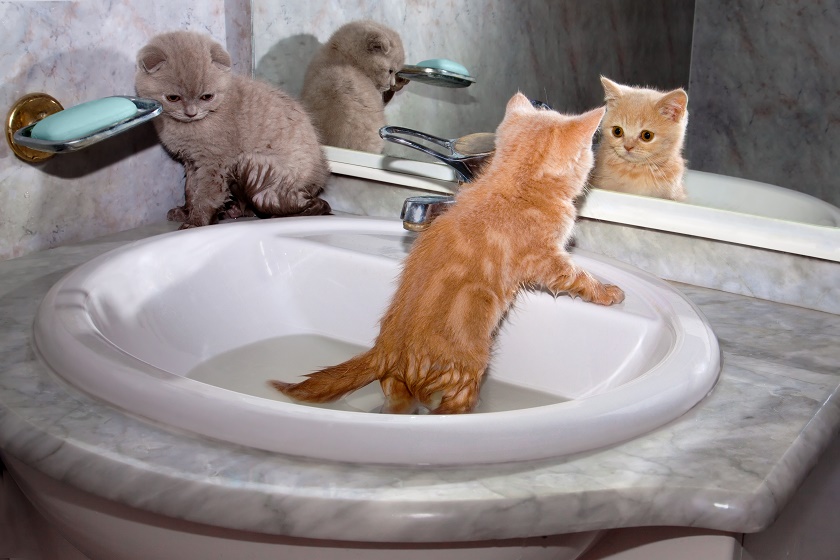Adopt A Cat Month: 7 Cat Owner Mistakes
Post by Blog Manager Robbi Hess
It’s Adopt A Cat Month but that doesn’t mean that everyone should rush out and get a cat or a kitten. Adopting a pet, whether it’s a cat, lizard, dog, bird or ferret requires thought and planning because you’re making a lifetime commitment. A pet isn’t as easy to return as an ill fitting pair of shoes, nor should it be. When you open your heart and your home to a pet it is for the duration — until  death do you part.
death do you part.
If you’ve decided that it is time to either bring home your first cat or kitten or to expand your family by adding another one, here are some mistakes you want to avoid:
- Spaying and neutering are not optional. If you adopt from a shelter, the cat or kitten will come to you having already been spayed or neutered. If you get a kitten from a roadside “free kittens” environment, you will need to take on the responsibility yourself. A spayed or neutered animal will help cut down on the overpopulation and can prevent some annoying habits later in life if the pet is not spayed or neutered.
- Not planning for the costs of ongoing veterinarian care. Just as you take your children to the doctor when they need well-child check ups and for vaccinations and when they get ill, so too will you need to take your fur-kid to the vet for the same things. Vaccinations and check ups need to be budgeted for as will emergency visits… because you just never know when your pet will fall ill or suffer an injury.
- Cheaper is not cheaper in the long run… when it comes to cat food. Cats need to have wet food because they tend to not drink as much as they should and without that additional moisture that comes from wet food, your pet could suffer kidney problems and infections. Cats are carnivores and need meat more than they need grain and corn. Look for high quality foods, because the up front cost can save you money and health issues for your cat in the long run.
- Letting your cat be an “outdoor” cat. Letting your cat roam the neighborhood could lead to her being injured by a car, another cat, a dog or any other number of mishaps. Many cat owners will take their cats out of doors on leashes or even take a large dog crate outside just to let the cat feel the grass under her feet and get some fresh air. While some may argue this point, I have currently have four cats and none of them appear to be suffering from not being allowed to roam free. When I was growing up we had “barn cats” that lived with the horse and our family spent a lot of time and money keeping them safe from harm and while we did our best, we simply couldn’t keep track of them all (when you have a barn, people seem to believe they can simply dump off their litters). It was heartbreaking when they got hurt and made their way back to us for their final moments.
- Not having enough litter boxes and/or not cleaning them frequently enough. Litter box issues are the number one reason cats are surrendered to shelters. With our four cats we have three litter boxes and we clean them daily. We have also found that our cats prefer their litter boxes in the backroom (even though they are by the washer and dryer) to any other room in the house that we’ve tried. Litter box avoidance issues can be addressed in some cases by simply moving a litter box and making certain it is clean. Cats are fastidious and like a clean area to “do their business.”
- Let your cat be a cat. In some instances, people believe that their cat, if it’s an “only child” will cling to the owner and follow her around the way a dog would. Chances are, it won’t. Cats are, for the most part, solitary creatures who will come to you when they want to be petted and loved upon. Of our four cats, Jessie is the most loving and vocal, Clyde rushes to greet my daughter when she comes home, Parker will only sit on your lap if you don’t pet him (petting leads to him biting) and Lucy is aloof to the point of being inconsiderate, she will sit on your lap on rare occasions and only for brief moments. While I would love my cats to be as enthusiastic about me as Henrietta, the Diva Poodle is, I know they won’t… they are cats after all.
- Believing that declawing is necessary for an indoor cat. Prior to my becoming immersed in the pet industry I believed that indoor cats HAD to be declawed because that was what my mother believed. Once I became a cat owner myself I realized that I could “train” my cats to scratch on appropriate items and not my furniture and will never have a cat declawed again. Keeping your cats’ nails trimmed and offering them appropriate scratching posts and other scratching items will keep your furniture intact.
Are there any cat owner mistakes I’ve missed? Please share your thoughts.
(Photo Shutterstock: Kittens in sink)




